
NGC 936 is a barred lenticular galaxy in the constellation Cetus. It is at a distance of about 60 million light-years away from Earth. Its nucleus and prominent bar have high surface brightness. Because of the shape of the prominent bar, the nucleus and the ring of stars at the end of the barrel, the galaxy has been compared with the shape of a TIE fighter, from the Star Wars universe, and thus NGC 936 has been named Darth Vader’s Galaxy or Darth Vader’s Starfighter. By measuring the radial velocity of the disc, Kormendy found in 1986 that the disc is stable, which is the reason why it is so smooth.

NGC 596 is an elliptical galaxy in the constellation Cetus. The galaxy lies 65 million light years away from Earth, which means, given its apparent dimensions, that NGC 596 is approximately 60,000 light years across. The galaxy shows an outer envelope and is a merger remnant. The surface brightness profil is smooth and featureless. The galaxy hosts a supermassive black hole, whose mass is estimated to be 170 million (108.24) .

NGC 3642 is a spiral galaxy in the constellation Ursa Major. The galaxy has a low-ionization nuclear emission-line region. It is located at a distance of circa 30 million light years from Earth, which, given its apparent dimensions, means that NGC 3642 is about 50,000 light years across. The galaxy is characterised by an outer pseudoring, which was probably formed after the accretion of a gas rich dwarf galaxy.

NGC 4274 is a barred spiral galaxy located in the constellation Coma Berenices. It is located at a distance of circa 45 million light years from Earth, which, given its apparent dimensions, means that NGC 4274 is about 95,000 light years across. It was discovered by William Herschel in 1785.

NGC 3631 is a spiral galaxy located in the constellation Ursa Major. It is located at a distance of about 35 million light years from Earth, which, given its apparent dimensions, means that NGC 3631 is about 60,000 light years across. It was discovered by William Herschel on April 14, 1789. It is a grand design spiral galaxy seen face on.

NGC 3726 is a barred spiral galaxy located in the constellation Ursa Major. It is located at a distance of circa 45 million light years from Earth, which, given its apparent dimensions, means that NGC 3726 is about 85,000 light years across. It was discovered by William Herschel on February 5, 1788.
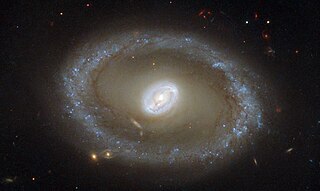
NGC 3081 is a barred lenticular ring galaxy in the constellation of Hydra. NGC 3081 is located about 85 million light-years away from Earth, which means, given its apparent dimensions, that NGC 3081 is approximately 60,000 light-years across. It is a type II Seyfert galaxy, characterised by its bright nucleus. It was discovered by William Herschel on 21 December 1786.
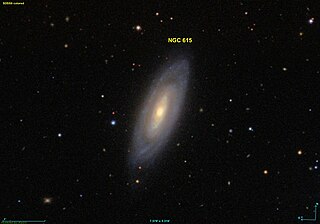
NGC 615 is an unbarred spiral galaxy seen edge-on located in the constellation Cetus. It is located at a distance of circa 70 million light years from Earth, which, given its apparent dimensions, means that NGC 615 is about 75,000 light years across. It was discovered by William Herschel on January 10, 1785. NGC 615 belongs to the NGC 584 galaxy group, which also includes the galaxies NGC 584, NGC 596, NGC 600, and NGC 636.
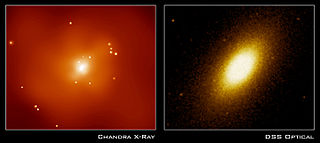
NGC 720 is an elliptical galaxy located in the constellation Cetus. It is located at a distance of circa 80 million light years from Earth, which, given its apparent dimensions, means that NGC 720 is about 110,000 light years across. It was discovered by William Herschel on October 3, 1785. The galaxy is included in the Herschel 400 Catalogue. It lies about three and a half degrees south and slightly east from zeta Ceti.
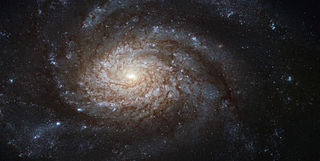
NGC 3810 is a spiral galaxy located in the constellation Leo. It is about 50 million light years from Earth, and estimated to be about 60,000 light years in diameter. William Herschel discovered it on 15 March 1784.

NGC 3893 is a spiral galaxy located in the constellation Ursa Major. It is located at a distance of circa 50 million light years from Earth, which, given its apparent dimensions, means that NGC 3893 is about 70,000 light years across. It was discovered by William Herschel on February 9, 1788. NGC 3893 interacts with its satellite, NGC 3896.

NGC 7606 is a spiral galaxy located in the constellation Aquarius. It is located at a distance of circa 100 million light years from Earth, which, given its apparent dimensions, means that NGC 7606 is about 165,000 light years across. It was discovered by William Herschel on September 28, 1785. The galaxy is included in the Herschel 400 Catalogue. It lies 45 arcminutes northeast from psi2 Aquarii. It can be seen with a 4 inch telescope but its visibility is greatly affected by light pollution.

NGC 7723 is a barred spiral galaxy located in the constellation Aquarius. It is located at a distance of circa 90 million light years from Earth, which, given its apparent dimensions, means that NGC 7723 is about 95,000 light years across. It was discovered by William Herschel on November 27, 1785. The galaxy is included in the Herschel 400 Catalogue. It lies 1.5 degrees north-northwest from Omega1 Aquarii. It can be seen with a 4-inch telescope under dark skies.

NGC 7184 is a barred spiral galaxy located in the constellation Aquarius. It is located at a distance of circa 100 million light years from Earth, which, given its apparent dimensions, means that NGC 7184 is about 175,000 light years across. It was discovered by William Herschel on October 28, 1783.

NGC 7741 is a barred spiral galaxy located in the constellation Pegasus. It is located at a distance of circa 40 million light years from Earth, which, given its apparent dimensions, means that NGC 7741 is about 50,000 light years across. It was discovered by William Herschel on September 10, 1784.

NGC 6907 is a spiral galaxy located in the constellation Capricornus. It is located at a distance of about 120 million light-years from Earth, which, given its apparent dimensions, means that NGC 6907 is about 115,000 light-years across. It was discovered by William Herschel on July 12, 1784. The total infrared luminosity of the galaxy is 1011.03 L☉, and thus it is categorised as a luminous infrared galaxy.
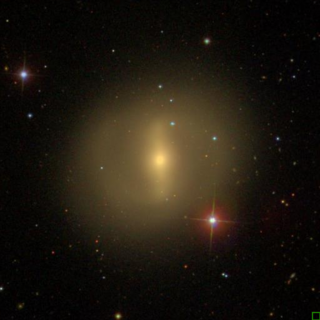
NGC 4665, also catalogued as NGC 4624 and NGC 4664, is a barred lenticular or spiral galaxy located in the constellation Virgo. It is a member of the Virgo II Groups, a series of galaxies and galaxy clusters strung out from the southern edge of the Virgo Supercluster. It is located at a distance of circa 60 million light years from Earth, which, given its apparent dimensions, means that NGC 4665 is about 75,000 light years across. NGC 4665 lies 2 and 3/4 degrees east-south east of Delta Virginis and 50 arcminutes southwest of 35 Virginis. It can be viewed through a moderately sized telescope with 23x magnification, forming a pair with an 11th magnitude star 1.5 arcminutes southwest. It is part of the Herschel 400 Catalogue.

NGC 5846 is an elliptical galaxy located in the constellation Virgo. It is located at a distance of circa 90 million light years from Earth, which, given its apparent dimensions, means that NGC 5846 is about 110,000 light years across. It was discovered by William Herschel on February 24, 1786. It lies near 110 Virginis and is part of the Herschel 400 Catalogue. It is a member of the NGC 5846 Group of galaxies, itself one of the Virgo III Groups strung out to the east of the Virgo Supercluster of galaxies.
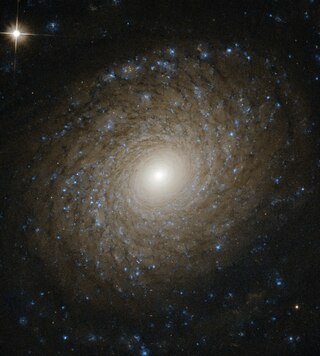
NGC 2985 is a spiral galaxy located in the constellation Ursa Major. It is located at a distance of circa 70 million light years from Earth, which, given its apparent dimensions, means that NGC 2985 is about 95,000 light years across. It was discovered by William Herschel on April 3, 1785.

NGC 7418 is an intermediate spiral galaxy located in the constellation Grus. It is located at a distance of circa 60 million light-years from Earth, which, given its apparent dimensions, means that NGC 7418 is about 60,000 light-years across. It was discovered by John Herschel on August 30, 1834.




















